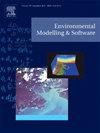Approximate Bayesian inference for calibrating the IPCC tier-2 steady-state soil organic carbon model for Canadian croplands using long-term experimental data
IF 4.8
2区 环境科学与生态学
Q1 COMPUTER SCIENCE, INTERDISCIPLINARY APPLICATIONS
引用次数: 0
Abstract
We conducted a Bayesian calibration of the IPCC tier-2 Steady-State (IPCCT2) model using long-term experimental (LTE) data from Canadian croplands. A global sensitivity analysis identified key parameters influencing the prediction of soil organic carbon (SOC) stocks, including those governing the temperature response curve, optimal decay rate in the passive pool, and stabilization efficiencies for decay products in different pools. We used Sampling-Importance-Resampling to obtain posterior parameter and hyperparameter distributions for the sensitive parameters and the tillage disturbance modifiers.
The calibration significantly narrowed parameter ranges compared to the original parameter range provided by the IPCC guidelines, reducing relative uncertainty in SOC point estimates from 27-33 % to 3.5–4 % - an 85 % reduction in model uncertainties. However, calibration was much less efficient in reducing model uncertainties if the correlation structure in the posterior samples was unaccounted for. Calibrated parameters effectively minimized Root Mean Squared Error and bias in SOC predictions in a validation dataset. The default IPCC tier-2 steady-state model parameters performed comparably to those obtained from maximum a priori distributions.
Our findings highlighted the broad nature of original IPCC guideline boundaries, leading to uncertain SOC stock predictions and limiting model informativeness and emphasizing the need for parties to adapt parameters to their country-specific conditions. Simulation results suggested that the calibrated model parameter ranges are essential for accurate predictions. When simulating the impact of reducing tillage or adding inorganic nitrogen to annual crops without manure amendments, model calibration substantially reduced uncertainties in long-term impact predictions—by ∼15 % for tillage and ∼75 % for nitrogen addition.
This study underscores the accuracy of default IPCCT2 parameters in simulating SOC dynamics in Canadian LTE studies. However, it emphasizes the need for calibrated model parameters in conducting uncertainty analyses. The Bayesian calibration improved uncertainty assessments of cropland management practices leading to reliable carbon accounting. This work supports informed decision-making towards sustainable agriculture, guiding management strategies that optimize carbon storage while aligning with national and international carbon reporting frameworks.
基于长期实验数据的加拿大农田IPCC第2层稳定土壤有机碳模型的近似贝叶斯推理校正
我们利用来自加拿大农田的长期实验(LTE)数据对IPCC第2层稳态(IPCCT2)模型进行了贝叶斯校准。通过全局敏感性分析,确定了影响土壤有机碳储量预测的关键参数,包括控制温度响应曲线、被动池中最优衰变速率和不同池中衰变产物稳定效率的参数。采用采样-重要-重采样的方法得到了敏感参数和耕作扰动修正因子的后验参数和超参数分布。与IPCC指南提供的原始参数范围相比,校准显着缩小了参数范围,将SOC点估计的相对不确定性从27- 33%降低到3.5 - 4%,即模式不确定性降低了85%。然而,如果后验样本中的相关结构未被考虑在内,则校准在减少模型不确定性方面的效率要低得多。校准后的参数有效地最小化了验证数据集中SOC预测的均方根误差和偏差。默认的IPCC第2层稳态模型参数的表现与从最大先验分布中获得的参数相当。我们的研究结果强调了原始IPCC指南边界的广泛性,导致SOC储量预测不确定,限制了模型的信息量,并强调缔约方需要根据本国具体情况调整参数。仿真结果表明,校正后的模型参数范围对准确预测至关重要。在模拟减少耕作或在不加肥料的情况下向一年生作物添加无机氮的影响时,模型校准大大降低了长期影响预测的不确定性——耕作减少了~ 15%,添加氮减少了~ 75%。这项研究强调了默认IPCCT2参数在模拟加拿大LTE研究中SOC动态的准确性。然而,它强调在进行不确定性分析时需要校准模型参数。贝叶斯校准改进了农田管理实践的不确定性评估,从而实现了可靠的碳核算。这项工作支持可持续农业的知情决策,指导优化碳储存的管理战略,同时与国家和国际碳报告框架保持一致。
本文章由计算机程序翻译,如有差异,请以英文原文为准。
求助全文
约1分钟内获得全文
求助全文
来源期刊

Environmental Modelling & Software
工程技术-工程:环境
CiteScore
9.30
自引率
8.20%
发文量
241
审稿时长
60 days
期刊介绍:
Environmental Modelling & Software publishes contributions, in the form of research articles, reviews and short communications, on recent advances in environmental modelling and/or software. The aim is to improve our capacity to represent, understand, predict or manage the behaviour of environmental systems at all practical scales, and to communicate those improvements to a wide scientific and professional audience.
 求助内容:
求助内容: 应助结果提醒方式:
应助结果提醒方式:


